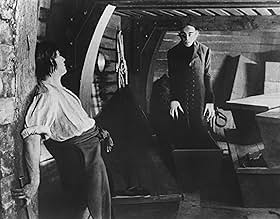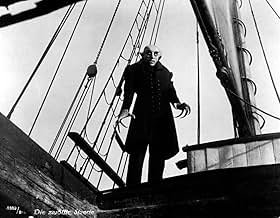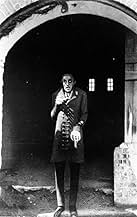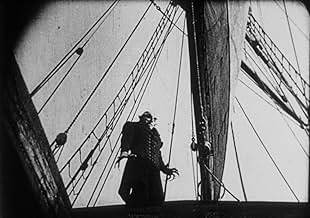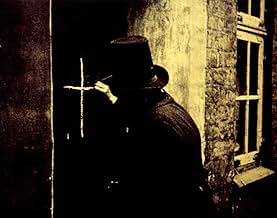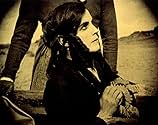अपनी भाषा में प्लॉट जोड़ेंVampire Count Orlok expresses interest in a new residence and real estate agent Hutter's wife.Vampire Count Orlok expresses interest in a new residence and real estate agent Hutter's wife.Vampire Count Orlok expresses interest in a new residence and real estate agent Hutter's wife.
- निर्देशक
- लेखक
- स्टार
- पुरस्कार
- 3 जीत और कुल 2 नामांकन
Gustav von Wangenheim
- Hutter
- (as Gustav v. Wangenheim)
Greta Schröder
- Ellen - seine Frau
- (as Greta Schroeder)
Georg H. Schnell
- Harding - ein Reeder
- (as G.H. Schnell)
Karl Etlinger
- Kontrolleur am Kai
- (बिना क्रेडिट के)
Hans Lanser-Ludolff
- A magistrate
- (बिना क्रेडिट के)
Loni Nest
- Child at Window
- (बिना क्रेडिट के)
Fritz Rasp
- Knocks Mitarbeiter
- (बिना क्रेडिट के)
Josef Sareny
- Head Coachman
- (बिना क्रेडिट के)
Fanny Schreck
- Krankenschwester im Hospital
- (बिना क्रेडिट के)
Eric van Viele
- Matrose 2
- (बिना क्रेडिट के)
फ़ीचर्ड समीक्षाएं
F.W. Murnau set the bar high for vampire movies, very high. Can not help but start praising the job Max Schreck and Murnau did to bring Count Orlok character to life on the screen. Orlok's face, hands and slender build along with his sly shuffling movements with the right camera angles and props brought a hell of a lot of general creepiness. The viewers in the twenties must have been shell shocked because they didn't tame it down which they most often did in this time period. For a full length silent feature film I found the time going fairly fast with a view dragged out scenes, that can be expected. The big bugaboo I have with Nosferatu though is the questionable ending being terribly anticlimactic. Regardless of the disappointing ending, Nosferatu is a killer film that is a must watch for horror or classic movie fans.
For copyright reasons, Bram Stoker's novel was filmed with the names of the characters changed (Orlok for Dracula, for example) but otherwise the story remains the same: a young man goes on a trip to see a mysterious count in order to sell a house, leaving his bride behind, and finds that the creature he meets is not of this world.
As the extremely creepy Orlok, Max Schreck is brilliant, with his long fingernails and gaunt appearance. A triumph in early cinematic make-up. Gustav von Wangenheim portrays the confusion of the victim well, as does Greta Schroder as his wife. FW Murnau directed the film with flair, showing us not only shadowed vistas and abandoned castles, but the nature outside (foxes) and miniature worlds evolving under a microscope. This film sits well with his later 'Sunrise' in showing the effect of outside forces on a young couple, as well as being one of the key early horrors in its portrayal of Stoker's anti-hero.
This version of the Dracula tale remains one of the best, although all have some different perspective on the novel. On the strength of 'Nosferatu' alone, Murnau deserves his place as a true innovator of silent cinema.
As the extremely creepy Orlok, Max Schreck is brilliant, with his long fingernails and gaunt appearance. A triumph in early cinematic make-up. Gustav von Wangenheim portrays the confusion of the victim well, as does Greta Schroder as his wife. FW Murnau directed the film with flair, showing us not only shadowed vistas and abandoned castles, but the nature outside (foxes) and miniature worlds evolving under a microscope. This film sits well with his later 'Sunrise' in showing the effect of outside forces on a young couple, as well as being one of the key early horrors in its portrayal of Stoker's anti-hero.
This version of the Dracula tale remains one of the best, although all have some different perspective on the novel. On the strength of 'Nosferatu' alone, Murnau deserves his place as a true innovator of silent cinema.
F.W. Murnau's version of the 'Dracula' legend still remains as distinctive and memorable as ever. The enjoyable Bela Lugosi version is perhaps easier to watch, and strictly as light entertainment it might work better, and many later versions brought their own interpretations - but nothing matches "Nosferatu" for its engrossingly morbid atmosphere and its unusual interpretation of the main character.
Max Schreck and Murnau were able to create an image of the vampire that remains in your mind long after seeing it. Regardless of whether it or some other conception is closest to the 'true' Dracula (if such a thing even exists), it is quite effective, and it was particularly well-conceived for a silent screen version that cannot rely on dialogue to define a character. The settings and the story perfectly complement Schreck's weird character, creating an atmosphere full of constant strangeness, uncertainty, and foreboding.
It's unnecessary (and probably impossible) to make detailed comparisons among all the film versions of the Dracula character and legend. "Nosferatu" stands perfectly well on its own, as a unique and skillfully done adaptation of the story, and as one of the memorable classics of the silent era.
Max Schreck and Murnau were able to create an image of the vampire that remains in your mind long after seeing it. Regardless of whether it or some other conception is closest to the 'true' Dracula (if such a thing even exists), it is quite effective, and it was particularly well-conceived for a silent screen version that cannot rely on dialogue to define a character. The settings and the story perfectly complement Schreck's weird character, creating an atmosphere full of constant strangeness, uncertainty, and foreboding.
It's unnecessary (and probably impossible) to make detailed comparisons among all the film versions of the Dracula character and legend. "Nosferatu" stands perfectly well on its own, as a unique and skillfully done adaptation of the story, and as one of the memorable classics of the silent era.
Nosferatu is a great horror movie (possibly the first ever according to some accounts), and one of the pinnacles of the German silent era of film-making. Made in the silent age by the German expressionist/auteur FW Murnau, the film has the genuine power to act creepy, odd, alluring, mythic, and beautiful by way of images and music that don't leave your mind once the film is over. It's like someone collected a stash of nightmares and pulled them together with the original Bram Stoker story of Dracula. Max Shreck, in his most notorious role (and apparently the only one really anyone's bothered to see) plays the monstrous Count Orlock, a vampire who comes out at night to tempt the living and, of course, to suck blood. Though this story of Dracula has been numerously repeated (even by the Hollywood version in the early 30s), this film is one of the prime examples of how horror SHOULD be done- dispense with cheap thrills or overloading with exposition.
A director like Murnau here, who had total artistic control (abeit the film not in circulation for many years), could transform Orlock's world into one of acute, deliberate angles, long deep shadows, and painting with light like some mad artist from the dark ages. One could almost claim that this, alongside Night of the Living Dead, changed the way audiences looked at horror films, that a style and presence could be wrung from characters that bring out the worst fears and dread in common people. Years from now, long into the digital age, there may still be room for of all things a silent, non-talking effort like Nosferatu, where the terror can still be felt through the black and white (sometimes tinted) photography and stark physical performances by Schrek and the others. In short, a film like this is one of the reasons I love to watch horror movies.
A director like Murnau here, who had total artistic control (abeit the film not in circulation for many years), could transform Orlock's world into one of acute, deliberate angles, long deep shadows, and painting with light like some mad artist from the dark ages. One could almost claim that this, alongside Night of the Living Dead, changed the way audiences looked at horror films, that a style and presence could be wrung from characters that bring out the worst fears and dread in common people. Years from now, long into the digital age, there may still be room for of all things a silent, non-talking effort like Nosferatu, where the terror can still be felt through the black and white (sometimes tinted) photography and stark physical performances by Schrek and the others. In short, a film like this is one of the reasons I love to watch horror movies.
F.W. Murnau directs this unauthorized version of Bram Stoker's novel, Dracula. NOSFERATU is arguably the earliest surviving screen version depicting the 'Prince of Darkness'. This German production deviates slightly from the original, but the now familiar story we all know by heart is intact. Count Dracula becomes Count Orlok and journeys to Bremen, Germany instead of London. His physical appearance is not dashing, mesmerizing or even mystical; but much resembles the rats that frequently accompany him. I find this the most eerie of all that would follow. The accompanying organ music background makes this scratchy black and white silent film an essential masterpiece. Max Schreck is immortal as Nosferatu/Count Orlok.
क्या आपको पता है
- ट्रिवियाThe movie was banned in Sweden due to excessive horror. The ban was finally lifted in 1972.
- गूफ़(at around 30 mins) When Hutter is writing his letter to Ellen in Count Orlok's castle, the paper that he is meant to be writing on is clearly blank throughout the scene.
- भाव
Graf Orlok: Your wife has such a beautiful neck...
- इसके अलावा अन्य वर्जनThere are a confusing number of different surviving prints, restorations and alternate versions of Nosferatu. In the main, there are three 'complete' restorations and two incomplete, partially-restored versions. All five are available on DVD, while the latest two restorations, from 1995 and 2006, are also on Blu-ray. In addition there are countless low-quality public domain DVDs with different lengths, running speeds and soundtracks. All are derived from a single print held by the Museum of Modern Art (MoMA). They usually have replacement American intertitles and are always in black and white; the film was originally color tinted throughout and only meant to be seen that way. This comprehensive article explains all of them simply and clearly: Nosferatu: The Ultimate Blu-ray and DVD Guide.
- साउंडट्रैकJeux d'enfants - Galop
Written by Jack Norworth
[Plays during the croquet scene in the 2006 restoration]
टॉप पसंद
रेटिंग देने के लिए साइन-इन करें और वैयक्तिकृत सुझावों के लिए वॉचलिस्ट करें
विवरण
- रिलीज़ की तारीख़
- कंट्री ऑफ़ ओरिजिन
- आधिकारिक साइट
- भाषाएं
- इस रूप में भी जाना जाता है
- Nosferatu
- फ़िल्माने की जगहें
- Starhrad Castle, Nezbudská Lúcka, Slovakia(castle in ruins)
- उत्पादन कंपनियां
- IMDbPro पर और कंपनी क्रेडिट देखें
बॉक्स ऑफ़िस
- दुनिया भर में सकल
- $48,892
- चलने की अवधि
- 1 घं 34 मि(94 min)
- ध्वनि मिश्रण
- पक्ष अनुपात
- 1.33 : 1
इस पेज में योगदान दें
किसी बदलाव का सुझाव दें या अनुपलब्ध कॉन्टेंट जोड़ें


